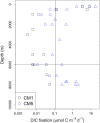Sedimentary supply of humic-like fluorescent dissolved organic matter and its implication for chemoautotrophic microbial activity in the Izu-Ogasawara Trench
- PMID: 34561465
- PMCID: PMC8463680
- DOI: 10.1038/s41598-021-97774-7
Sedimentary supply of humic-like fluorescent dissolved organic matter and its implication for chemoautotrophic microbial activity in the Izu-Ogasawara Trench
Abstract
Microbial community structure in the hadal water is reported to be different from that in the upper abyssal water. However, the mechanism governing the difference has not been fully understood. In this study, we investigate the vertical distributions of humic-like fluorescent dissolved organic matter (FDOMH), chemoautotrophic production, apparent oxygen utilization (AOU), and N* in the Izu-Ogasawara Trench. In the upper abyssal waters (< 6000 m), FDOMH has a significantly positive correlation with AOU; FDOMH deviates from the relationship and increases with depth without involving the increment of AOU in the hadal waters. This suggests that FDOMH is transferred from the sediments to the hadal waters through pore water, while the FDOMH is produced in situ in the upper abyssal waters. Chemoautotrophic production and N* increases and decreases with depth in the hadal waters, respectively. This corroborates the effluxes of dissolved substances, including dissolved organic matter and electron donors from sediments, which fuels the heterotrophic/chemoautotrophic microbial communities in the hadal waters. A simple box model analysis reveals that the funnel-like trench topography facilitates the increase in dissolved substances with depth in the hadal waters, which might contribute to the unique microbiological community structure in these waters.
© 2021. The Author(s).
Conflict of interest statement
The authors declare no competing interests.
Figures





References
-
- Glud RN, et al. High rates of microbial carbon turnover in sediments in the deepest oceanic trench on Earth. Nat. Geosci. 2013;6(4):284–288. doi: 10.1038/ngeo1773. - DOI
-
- Kawagucci S, et al. Hadal water biogeochemistry over the Izu-Ogasawara Trench observed with a full-depth CTD-CMS. Ocean Sci. 2018;14(4):575–588. doi: 10.5194/os-14-575-2018. - DOI
Publication types
LinkOut - more resources
Full Text Sources

